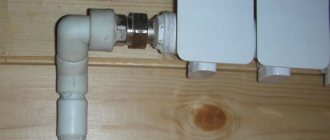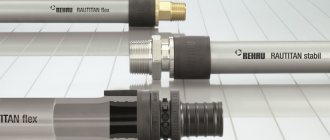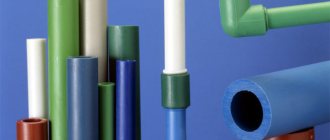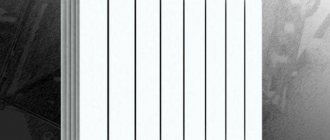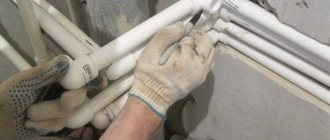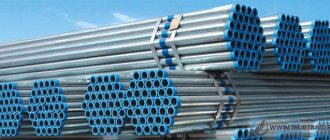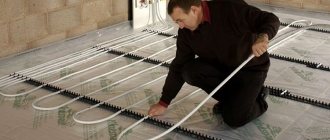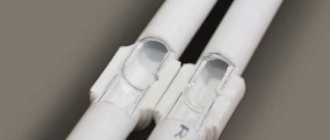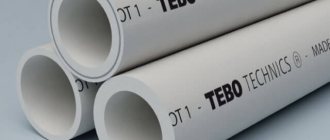Reinforced propylene pipes for heating When organizing hot water supply and equipping heating systems, an alternative solution is often sought to replace pipes made of copper and other equally expensive metals. Recently, reinforced polypropylene pipes are usually used for heating, which are an inexpensive analogue that is not inferior to traditional materials in durability, strength and reliability.
Scope of application
Reinforced polypropylene pipes are universal materials traditionally used to create sewer and water supply systems and organize heating.
Four-meter polypropylene pipes with a cross-section of 16–125 mm are intended for sewerage, and for water supply - with an outer diameter of up to 110 mm. A pipe with a cross-section of up to 17 mm is more suitable for installing heated floors.
Glass fiber reinforced polypropylene products of large diameters are in demand for the installation of ventilation systems. Due to its low weight, significant loads are not created on partitions and supporting structures.
PPR pipes are used in heating systems, hot and cold water supply.
PPR pipes are also in demand in agriculture - for creating irrigation and drainage systems. Due to their high performance characteristics, the products are used to create process pipelines transporting non-aggressive liquid and gaseous substances.
When laying under roads, despite the high strength of the products, they need to be protected with reinforced concrete boxes.
Installation of PP reinforced pipes
Installation with reinforcement is carried out using classical methods, even if a connection is made with reinforcement. Usually done:
- soldering using special welding equipment;
- threaded connection;
- cold welding (chemical bonding method).
The algorithm for joining aluminum-reinforced pipes includes the stage of stripping the welded area of foil. The process is carried out using a special device - a shaver.
Soldering is performed in the following order:
- The products are being prepared for installation. Workpieces are cut to the required length, cleaned, degreased, and the equipment is heated to a temperature of 260 °C. In this case, the welding machine does not turn off until soldering is completed.
- Pipe parts are heated by simultaneously inserting a straight section into the sleeve and sliding the fitting onto the mandrel. The processes are carried out without spinning the polymer elements.
- The parts are connected after removal from the welding machine. Upon completion of the joining, the elements are fixed in a stationary position while the polymer material cools.
The above steps allow you to obtain reliable sealed connections. Even beginners in the field of installation processes can perform soldering. It is necessary to observe the temperature and heating time, carry out all actions quickly and clearly.
Markings and characteristics
Despite the fact that reinforced polypropylene pipes are produced by many manufacturers, there is still no uniform marking system. Often, products made from the same material and having the same technical characteristics have different designations.
To avoid confusion and get your bearings in the names, you should understand the brands used in the manufacture of polypropylene blanks. Each type is designated by the Latin letters PP. Then the marking contains either alphabetic or numerical symbols indicating the type of PVC material:
- homopolymers (type 1), designated PRN-1, PP-1;
- block copolymers (type 2), marked PPV, PP-2;
- random copolymers (type 3), are designated as PPRC, PP-random, PPR.
The last type of plastic is the most modern. It has improved characteristics and, despite its considerable price, is ideal for heating systems.
The number following the letter designation indicates the maximum pressure that the polypropylene pipe can withstand. For example, a product marked PN 10 can be operated under operating pressure conditions of up to 10 Bar.
The functional purpose and main characteristics of PP pipes are presented in the table.
| Designation | Purpose | Water pressure, bar | Ambient temperature, °C |
| PN 10 | installation of heated floors, cold water supply | 10 | up to 450 |
| PN 16 | cold and hot water supply | 16 | up to 600 |
| PN 20 | hot water supply | 20 | up to 950 |
| PN 25 | hot water supply, central heating | 25 | up to 950 |
Types of propylene pipes
Since products made from this type of plastic are produced in a wide range, there are several types of classifications.
Various colors
The range of polypropylene pipes includes products of different colors. The most common mounting elements are white, green, gray and black.
As a rule, the shade of products is chosen arbitrarily and depends on the design of the pipes and manufacturers (some enterprises traditionally produce pipes of the same color, for example, green).
When choosing polypropylene pipes, you should also pay attention to the color of the products. This criterion is especially important if you plan to install an open system in living rooms or office spaces (bathroom, kitchen). The only exception is plastic products of a radical black hue.
As a rule, this color is an indicator of the maximum level of ultraviolet protection
The only exception is plastic products of a radical black hue. As a rule, this color is an indicator of the maximum level of ultraviolet protection.
Constructions of various types
Based on their internal structure, all polypropylene pipes can be distinguished into two fundamental categories:
- single-layer, consisting of one layer of plastic;
- multilayer (reinforced) from several shells, which consist not only of plastic, but also of materials that strengthen the structure, creating a durable frame.
Reinforced structures are preferable to single-layer ones, since in this case the thermal elongation of the pipe is significantly reduced.
Types of multilayer pipes
There are several options for multilayer pipes. The most commonly used reinforcement materials are aluminum and fiberglass.
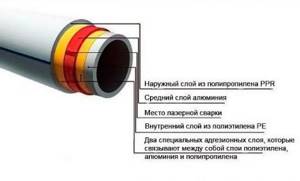
Schematic representation of a pipe reinforced with aluminum, indicating all layers, including adhesive ones. Such products are produced using a modern laser welding method.
Pipes reinforced with a continuous sheet of aluminum foil. When making such products, a smooth thin sheet of silver metal is applied to the outer side of the polypropylene blank.
Before installation, such pipes must be cleaned by cutting off the foil at a distance of approximately 1 mm from the edge. Skipping this process negatively affects the quality of the seam, which will turn out loose and unreliable.
Mounting elements, reinforcement with perforated aluminum sheet. One of the layers of such pipes is foil with holes punched in it. As in the previous case, before using such parts they should be cleaned.
It is important to note that products with perforated foil have a high oxygen permeability coefficient, so they should not be combined with heating boilers or similar equipment. Pipes with a core reinforced with aluminum sheet
In this case, the products are reinforced in the middle or even the inner part, so you can do without stripping before starting work
Pipes with a core reinforced with aluminum sheet. In this case, the products are reinforced in the middle or even the inner part, so you can do without stripping before starting work.
Fiberglass reinforced parts. The core of the pipe is most often made from this durable material, while its internal and external parts are made of polypropylene.

Pipes reinforced with fiberglass are deservedly popular. Such products are characterized by increased strength and rigidity, in addition, they can be used for welding without prior preparation
Composite reinforcement. For greater strength, the pipes also have a middle layer made of a combined material that combines polypropylene and glass fiber. Such pipes also have high consumer properties and do not require cleaning before use.
A type of multilayer PP elements are pipes that contain an additional layer of plastic. Such products can withstand high temperatures well, but contact between the transported liquid and the reinforced layer cannot be ruled out.
In addition, the coatings in such products are often glued together with glue, which under certain conditions can lead to delamination.
Types of reinforcement
Polypropylene pipes are also reinforced, which allows minimizing thermal expansion and improving the strength characteristics of the product.
Two types of reinforcing materials are used in production:
- fiberglass;
- aluminium foil.
Aluminum reinforcement
Reinforcement with thin sheet aluminum (foil) can be done both from the inside and along the outer layer of the pipe. For such pipe products, the designation PEX/Al/PEX is accepted. The sheet can be either solid (monolithic) or perforated.
There are two options for placing the foil: in the middle of the polypropylene layer or closer to the outer surface. In the first case, during installation it is necessary to perform trimming, in which the foil inside the pipe is cut off by 3–4 mm without destroying the plastic.
When the reinforcing layer is located near the outer surface, the likelihood of interaction between the metal and the coolant is completely eliminated.

Even purified water circulating through the pipe cannot be a completely chemically neutral substance. Almost always, in one concentration or another, it contains salts that react with the foil and destroy it. During installation, pipes require stripping, that is, removal of the top layer of plastic and reinforcement to create a reliable welded joint.
Glass fiber reinforcement
Plastic heating pipes reinforced with fiberglass are produced by coextrusion. In this case, the reinforcing layer is located in the middle.
Products made of polypropylene, reinforced with glass fiber, have low thermal conductivity and are used for assembling open heating systems.
The reinforcing material can be green, red, blue or orange. This is just a coloring pigment that is used by various manufacturers. You should focus on the strip drawn along the product, the color of which indicates its suitability for moving various media:
- red – for hot coolant;
- blue – for cold environments;
- the combination of blue and red colors indicates versatility of use.
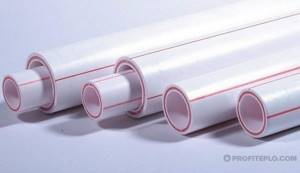
Glass fiber reinforcement
Conclusion
What conclusion can be drawn about the reinforcement of PP pipes?
- Reinforcement is needed to compensate for linear elongation during heating, as can be calculated in a separate paragraph.
- The reinforcement is made of aluminum in the form of solid foil on the outside of the pipe and inside, perforated foil on the outside is a drawback; such pipes must be cleaned before welding.
- A glass or basalt reinforced pipe replaces aluminum reinforcement in water supply systems, and an additional anti-diffusion layer on top of such a pipe makes it suitable for installation of heating systems.
Based on the knowledge you have acquired, you now know exactly what goes where, and when purchasing, all you have to do is focus on quality, price and labeling, which we will talk about in the next paragraph.
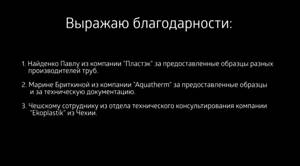
Selection options by criteria
The selection of pipes for certain operating conditions is carried out according to three most important criteria:
- working pressure;
- operating coolant temperature;
- diameter
Operating pressure
As already mentioned above, when designating products, this parameter is encrypted with the combination PN, and the number following the letters indicates the maximum permissible pressure in bars (1 Bar equals 0.1 MPa).
The selection of a pipe reinforced with aluminum or fiberglass is determined primarily by operating conditions. In case of frequent water hammer or the need for regular pressure testing in conventional pipelines, PN20 products are often used. For use at high temperatures (above 70 °C), it is necessary to use PN25 pipes.
For installation in the structure of autonomous or floor heating equipment operating under pressure up to 10 atmospheres, the PN20 grade with a perforated or solid aluminum reinforcing shell is suitable.
Operating coolant temperature
The most important parameter is the temperature of the circulating coolant. In heated floors, the temperature of the liquid, as a rule, does not exceed 40 ° C, therefore for their construction it is possible to use not only products with any type of reinforcement, but also an ordinary plastic pipe.
In radiator systems at coolant temperatures up to +85 °C, pipes reinforced with aluminum or fiberglass can be used.
Typically, manufacturers indicate the maximum permissible temperature directly on the surface of the product. This can be either a marking with a specifically indicated value, for example, “90 °C”, or an indication that the pipe can be used for hot liquid.
Pipe diameter
Reinforced plastic pipes are produced in various diameters, the selection of which is carried out in accordance with the ability to ensure the passage of a volume of coolant over a certain time interval:
- For the installation of heating systems in individual houses, the passage of the required volume of water is provided by pipes with a diameter of 20–32 mm. Their advantage is ease of installation, ease of creating bends, and a huge selection of fittings.
- For large facilities (hotel complexes, hospitals, public saunas and baths), pipes with a cross-section of 200 mm or more are used.
- Central heating requires pipes with a diameter of 25 mm.
- To install a “warm floor” system, it is better to purchase products with a small cross-section, up to 16 mm.
- Installation of risers is carried out from pipes with a diameter of 32 mm, ensuring unimpeded flow of coolant. For collector areas, products of larger cross-sections should be used.
Reinforcement inside
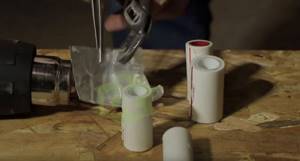
As a result, some changed the technology for manufacturing multilayer pipes. Others use modified glue. Still others hid the aluminum layer inside the pipe.

Still others left the reinforcement on the outside, but the aluminum foil became perforated.
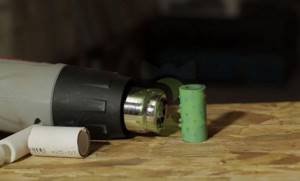
So what about the reliability of such a puff pastry? In the case of reinforcement in the middle of the pipe, there is still a potential risk of swelling of the layers. But it will not be visible to the user.
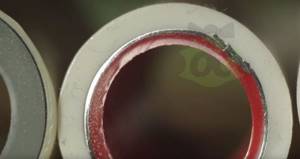
With such small swellings inside the pipe, the system will continue to work and the user will never know about it. But there is one thing. On one side, the layer of polypropylene between the reinforcements is quite large. It is much more difficult for such a layer of polypropylene to swell. But even if such swelling occurs, it will not be noticed throughout the entire operation of the system. But on the other hand, a serious problem can arise with such a system if an error is made either in the calculations of the system or during operation of the system.
Let's assume that a system is installed where a relief valve is installed (an emergency valve that relieves pressure), an expansion tank is installed and everything else. This system works properly and for a long time. Let's say 5 years have passed. The maintenance of this system has long been abandoned because no one knows that it needs to be maintained. The air from the expansion tank has long been released and the moment has come that either from the city network or the boiler is overheated, if it is a solid fuel boiler and 90° or 110° has flown into the system. At this temperature the pipe will not burst. Why it won’t burst, see the first paragraph of the PP course. At this moment the water expands. The water expanded and the relief valve activated. A relief valve drained excess water to prevent the system from rupturing. What will happen next? And then the system will cool down. If the system cools, then the water decreases in volume. If our expanzomat does not work, then where will the water come from if we do not have automatic replenishment? That's right. A vacuum will form in the system. So, during such a severe vacuum, weak sections of the pipe can collapse inward and completely block the coolant flow.
By the way, write in the comments whether you have encountered problems with swelling, both from the outside of the pipe and inside, and whether you have had to redo systems where the polypropylene pipe collapsed inside. If there are such, then also write the manufacturer.
With this post I do not want to say that a pipe reinforced with aluminum in the middle of the pipe is bad. I just want to say that if you make such a mistake during operation of the system, then such a pipe will most likely not forgive you for such a mistake. And you will have to pay very dearly for such a mistake. Outside minus 40, the heating system does not work. By the way, with such gross errors during installation or operation of the system, not only a polypropylene pipe can collapse. Therefore, be careful.
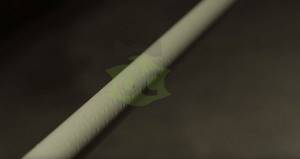
But the perforated foil, which is located on the outer layer of the pipe, does not have such a drawback, because inside there is a thick layer of polypropylene and in order to flatten it you need a very large vacuum. And swelling on the outside turned out to be a much rarer occurrence.

It turns out that the aluminum layer is held in place not only by the glue, but also by the fact that polypropylene is welded to polypropylene through these holes. The pipe looks and feels so pimply. But reliable.
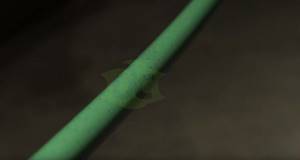
In view of all this, we get the disadvantages of a pipe that is reinforced with aluminum. First, the outer layer may swell and lose its appearance.
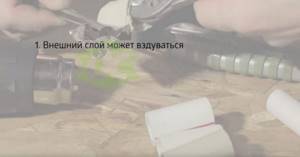
The outer layer must be cleaned before welding. Installation becomes more complicated.
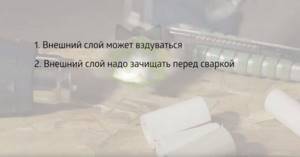
The inner layer also needs to be trimmed before welding.
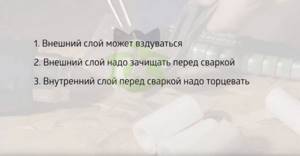
The inner layer of polypropylene can block the passage in case of an error.
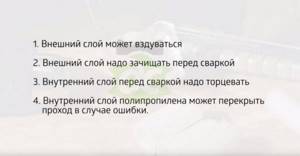
In view of these difficulties, another method of reinforcing polypropylene pipes was developed.
Advantages and disadvantages of fiberglass and aluminum reinforcement of PPR pipes
First of all, it should be noted that products, regardless of whether fiberglass or aluminum is used for reinforcement, have approximately the same thermal expansion parameter. According to this indicator, both types of products are equivalent.
Fiberglass reinforced pipe has a protective layer that completely covers the gap between the inner and outer layers of the base material. In this regard, the products have the following properties:
- tear resistance;
- reliability;
- durability (estimated operational life - 50 years).
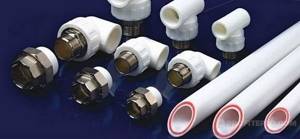
In the manufacture of aluminum-reinforced pipes, there is a weld on the reinforcing layer, and in cheap products, mainly of Asian or Turkish origin, the edges of the foil sheets are overlapped. The insulating characteristics, resistance to elevated temperatures and high pressure of such products are low.
The advantage of pipes with fiberglass reinforcement is the presence of an anti-diffusion layer that prevents contact of the coolant with oxygen, as a result of which the metal parts are not susceptible to corrosion processes.
When reinforcing products with foil, the manufacturer is not always able to make the protective layer continuous, therefore the danger of air contact with the coolant increases. In addition, the material itself is not resistant to corrosion.
Connections of fiberglass reinforced pipes do not require periodic testing of strength and density. The reliability of connections of aluminum-reinforced products largely depends on the quality of the cleaning performed and the selection of elements before assembly.
Foil-reinforced polypropylene has a glued wall construction. And if, during soldering, a section of metal remains at the end that directly interacts with the coolant, then it is in this place that delamination of the walls can occur, leading to heaving and subsequent rupture of the pipeline.

Delamination of reinforced pipe walls
The fiberglass reinforcing layer is an almost integral structure; soldering is carried out without the need for stripping or the use of special tools.
Pipes reinforced with glass fiber for heating have high thermal insulation properties, thereby minimizing heat loss.
Products reinforced with various materials equally have the following characteristics:
- polyvinyl chloride does not emit harmful substances either when cold or when heated, it is non-toxic and safe;
- the material tolerates the effects of active chemical compounds well and is resistant to the aggressive influence of insufficiently purified coolant;
- normal operating conditions are from 10 °C to 95 °C, while a short-term temperature increase can lead to slight sagging of the pipeline, but without the appearance of deformations.
What is reinforced PP pipe
Among all organic polymers, polypropylene occupies a special place. It creates durable and non-hazardous products. The disadvantages of non-reinforced material include sagging and deformation changes in pipelines when a very hot liquid medium moves through them.
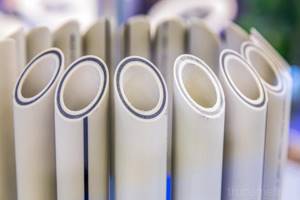
Reinforced polypropylene
The disadvantage of simple polypropylene is also linear thermal expansion. This disadvantage creates significant inconvenience during the operation of polymer heating networks or PP pipelines with hot water.
In communications, the length of pipes can increase to 10 mm per 1000 mm. Therefore, compensators must be installed in them to stabilize the elongation.
Due to the linear expansion of PP pipes, the appearance deteriorates and the cost of openly laid systems increases. When laying closed, there is a possibility that the integrity of the plaster layer will be damaged.
Reinforcement is a technology for strengthening rolled pipes. To do this, a layer of fiberglass or aluminum is added to the wall of the product.
The use of glass fibers is a new option for strengthening rolled polymer products. Polypropylene pipes reinforced with glass fiber are more durable. After all, fiberglass reduces ductility.
The capabilities of reinforced polymer pipes are almost the same as those of metal pipelines. At the same time, the advantages of polypropylene remain unchanged.
PP pipes with reinforcement have the following advantages:
- inertness to chemical influences;
- absence of emissions of harmful substances, which allows use in food industry enterprises;
- excellent smoothness of the inner part, unchanged over time and does not help the appearance of scale and sediment accumulation;
- minimal heat and noise conductivity;
- low price, which is less than that of metal analogues;
- light weight, allowing movement and transportation with minimal effort;
- small coefficient of longitudinal expansion, 5 times less than that of products made from conventional polypropylene;
- excellent resistance to high temperatures and heavy loads.
Despite the increased number of advantages, polymer reinforced pipe products are still easy to install. To complete the process, no special knowledge is required, which cannot be said about similar metal products.
Manufacturers
Fırat Plastik AS. A Turkish manufacturer offering a wide range of pipe products made of polypropylene, reinforced with fiberglass or aluminum, and all the fittings necessary for their connection.
PPR pipes produced by Fırat Plastik can be used in the temperature range from -20 to 95 °C.
When giving preference to products of this brand, you should know that they should not be stored in open areas for more than 180 days. The reason is the lack of a UV stabilizer.

FV-Plast. The Czech manufacturer offers three lines designed for different operating conditions:
- Classic – solid pipes, with a wall thickness of 2.7–18.3 mm with an outer diameter from 16 to 110 mm;
- Stabi – pipe products reinforced with aluminum foil, cross-section 16–110 mm and wall thickness 2.7–16.3 mm;
- Stabioxy PP-RCT - pipes with an aluminum layer that have maximum resistance to high temperatures and pressure, with low thermal expansion and increased flow of the working fluid.
FASER. A manufacturer that guarantees consistently high German quality of products. The best characteristics of pipe products are achieved through the use of only high-quality materials and fiberglass reinforcement.
Pipes of this brand are characterized by the lowest possible thermal expansion. We also produce all kinds of fittings required for the installation of pipelines.
WAVIN Ekoplastik. Another manufacturer from the Czech Republic with an excellent reputation. On the Russian market you can buy three types of pipe products:
- Stabi with aluminum protective layer;
- Fiber with glass fiber reinforcement;
- PPR - solid pipes.
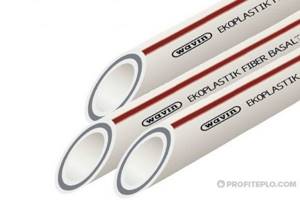
VALTEC. Joint Russian-Italian venture. It is distinguished by a wide range of produced polypropylene pipes and fastening parts:
- solid PPR pipes;
- products reinforced with a solid aluminum belt;
- with a fiberglass protective layer, capable of withstanding short-term excesses of permissible pressure and temperature without consequences;
- fittings and fittings.
Marking of polypropylene pipes with fiberglass
Polypropylene pipes reinforced with glass fiber are marked by leaving a longitudinal symbol strip on the outer shell.
It is worth noting that the order of arrangement and the presence of certain symbols differ among different manufacturers due to the lack of uniform standards. But any marking necessarily contains the dimensional parameters of the product and its pressure characteristics. Decoding of alphanumeric symbols in order of arrangement:
- Logo, trademark of the manufacturer.
- Product brand name
- Material of manufacture. Usually they use the standard designation - PP-R/GF/PP-R or PPR-GF-PPR (sometimes PPR-GF), where - PP-R is a random propylene copolymer; — GF — inner layer made of a mixture of polypropylene and fiberglass.
- SDR is a standard diameter to wall thickness ratio.
- S - series of pipes, shows the ratio of the outer diameter to the wall thickness. The indicator duplicates SDR and is related to it using the formula S = (SDR-1)/2.
- MRS - minimum long-term strength. It shows at what pressure the pipe can be guaranteed to serve a service life of 50 years, provided that it transports a working medium with a temperature not exceeding 20 °C.
- PN - nominal pressure, consists of the indicated symbol and number.
- Product diameter and wall thickness.
- The operating class is usually assigned to products from domestic manufacturers: - 1 - the product is designed for operation in hot water supply networks at a working environment temperature of no more than 50 °C. — 2 – for use in hot water supply lines at water temperatures up to 70 °C. — 3 – the product is suitable for use in low-temperature radiator heating with a heating fluid temperature of no more than 50 °C. – 4 – the pipe is intended for use in high-temperature radiator heating with a coolant temperature of up to 70 °C. — 5 – the product is designed for use in underfloor heating at a working environment temperature of no more than 90 °C. — HV – pipe is intended for use in cold water supply networks.
- Specifications, normative document or standard.
- Factory information: shift, batch, production date.
- Product barcode.
- Manufacturer country.

Rice. 9 Examples of marking PP pipes
Related article:
Autonomous heating system for a private house - a complete guide . How to properly organize an autonomous heating system, what materials and equipment to choose, how to organize everything correctly, what documents will be needed.
What is polypropylene?
Polypropylene is a material that by its nature is subject to significant elongation and expansion when heated.
Example:
A hot water supply system, 10 m long, is installed at a temperature of 200C, and water with a temperature of 1000C will pass through the pipe. With such a temperature difference, each meter of pipe can lengthen by 12 mm, respectively, with a pipe length of 10 m, the pipe will stretch by 12 cm.
That is why during the design and installation of heating or hot water supply systems, this property of polypropylene cannot be ignored for a number of reasons:
- a straight pipe will go in ugly waves. Especially if there is a long section;
- If the pipes are hidden in the wall, then there is a high probability of damage to the decorative coatings on the wall.
The reinforcement of polypropylene pipes is made precisely in order to reduce linear expansion when heated. This creates something like a rigid frame that prevents the pipe from elongating. At the same time, the reinforced pipe does not become stronger; the frame serves only to reduce the linear elongation. Is it worth choosing this type of polypropylene? Read on to learn more about types of reinforcement.
How to connect elements without soldering or welding?
For other situations, you need to use a detachable or threaded connection of polypropylene elements. These methods will allow you to easily disassemble the system or its separate section for repair, replacement or cleaning work.
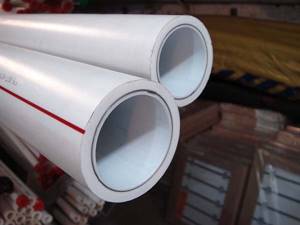
It does not allow for such high reliability and tightness as welding, but it does not require the use of brute force during disassembly. And with the right approach, the likelihood that the joint will leak is close to zero. The main thing is to use gaskets and securely insert the pipes into the couplings. Then no problems will arise during the entire period of operation. Connecting polypropylene pipes with fittings is one of the most popular methods.
It does not require special tools or a lot of effort. The main thing is that the end of the pipe is cut at a right angle and does not have burrs. Next, the pipes are simply inserted into the fitting of the required shape until it stops. For reliability, you can treat the joints with a special sealant.
The main condition for the reliability of the system in this case will be the correct selection of elements for the appropriate pipe diameter.
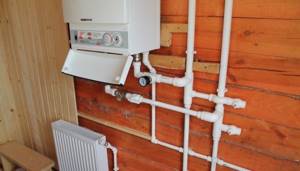
Flange connection of pipes is carried out using a special bushing. One part of it is welded to the end of the pipe, and the other is used to install shut-off valves. This type of connection is used in cases where it is necessary to install a tap that will regulate the operation of the entire system.
